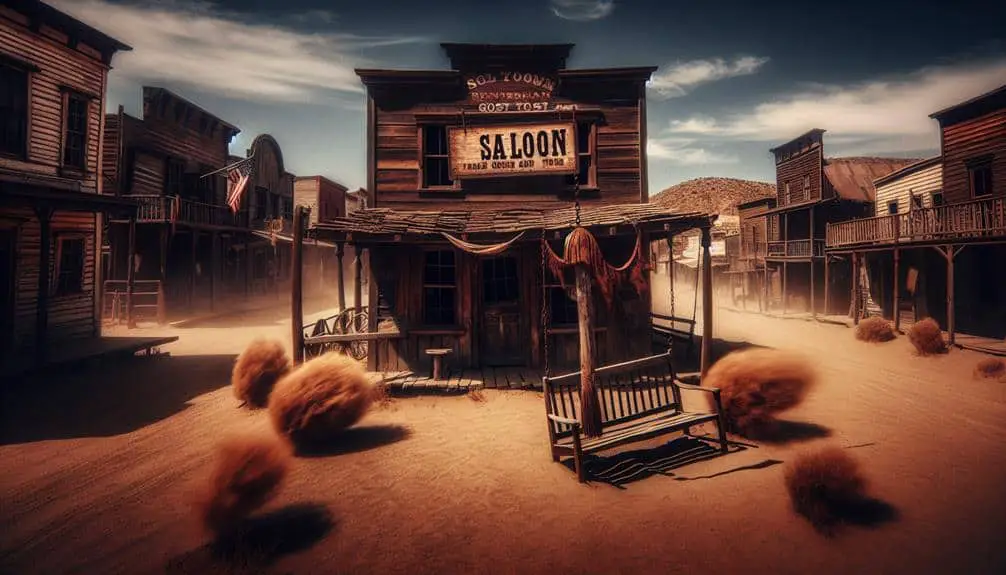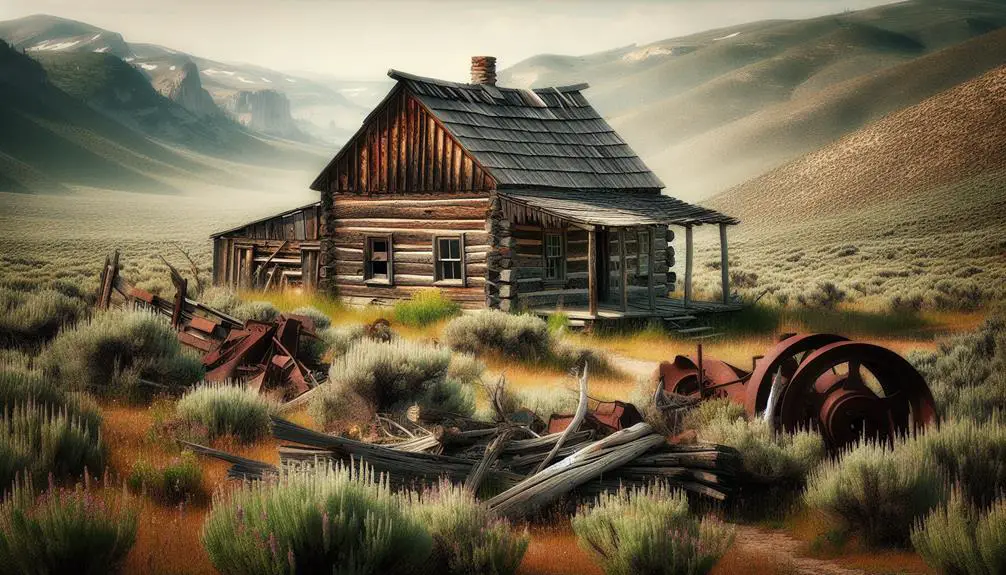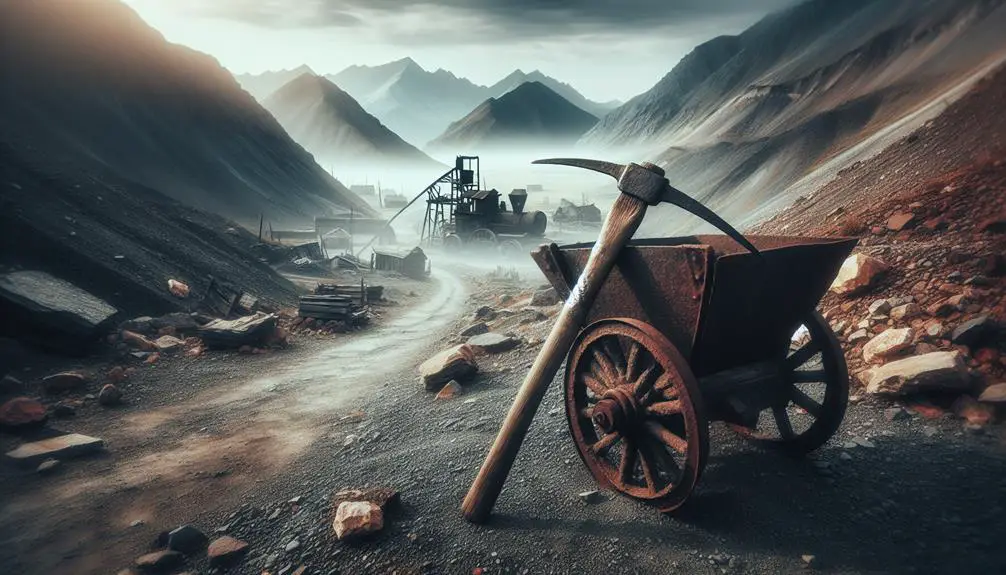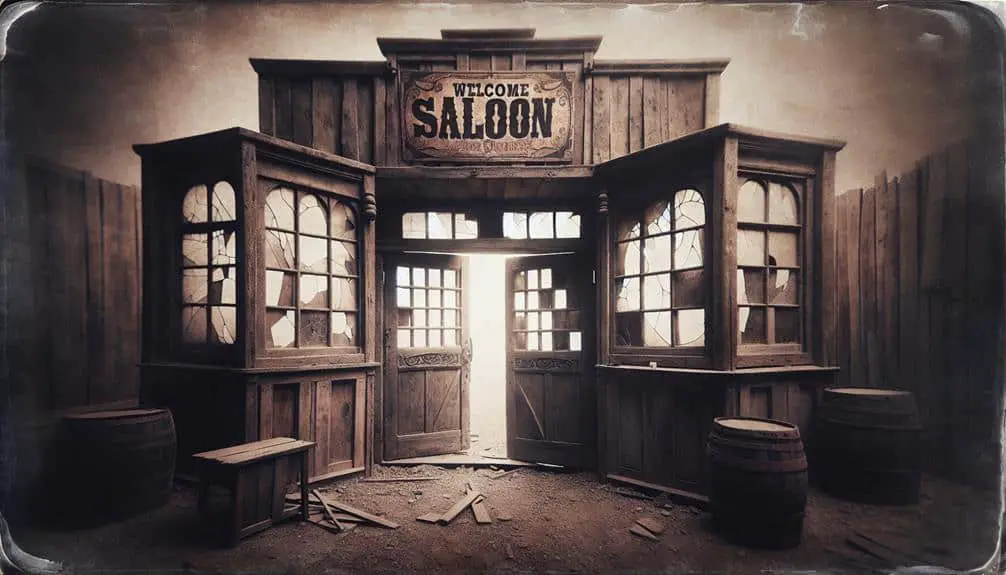Explore Goldfield, Nevada, a mix of Victorian, Romanesque, and Gothic architecture, once a bustling hub succumbing to economic decline. Bodie, California, frozen in the Gold Rush era, beckons with well-preserved buildings. Rhyolite, Nevada, born from gold in 1904, now whispers its mining history in haunting ruins. St. Elmo, Colorado, invites you to a well-preserved time capsule of frontier life. Bannack, Montana, a remote wilderness gem from 1862, preserves a rich mining legacy amid eerie tales of ghosts. Discover forgotten tales and rugged history in these abandoned US frontier ghost towns, each a poignant piece of the past.
Key Points
- Goldfield, Nevada: Victorian, Romanesque, Gothic styles, economic decline, preservation efforts maintain historical integrity.
- Bodie, California: Preserved buildings, ghost town frozen in time, glimpse into Gold Rush era.
- Rhyolite, Nevada: Abandoned frontier ghost town, haunting ruins, mining history glimpse, mystique with ghost stories.
- St. Elmo, Colorado: Well-preserved Rockies ghost town, gold, silver mining hub, paranormal experiences, frontier community glimpse.
- Bannack, Montana: Remote wilderness town, Montana gold rush history, National Historic Landmark, eerie atmosphere, local ghost legends.
Goldfield, Nevada
Nestled in the heart of Nevada's desert landscape, Goldfield stands as a tribute to the once-booming mining industry that thrived in the late 19th century. The town's architecture reflects its rich mining history, with buildings showcasing a blend of Victorian, Romanesque, and Gothic styles. As the mining industry prospered, Goldfield flourished, becoming a bustling hub in the early 1900s.
However, like many mining towns, Goldfield faced economic decline as precious metal deposits dwindled. The town's population plummeted, leaving behind a ghostly reminder of its former glory. Despite the challenges, preservation efforts have aimed to maintain Goldfield's historical integrity. Many buildings have been restored, offering visitors a glimpse into the past.
Exploring Goldfield allows you to witness the intricate details of a bygone era. From the ornate facades of the Goldfield Hotel to the sturdy structures of the Cook Bank Building, each edifice tells a story of resilience and perseverance. By delving into Goldfield's mining history and architectural marvels, you can truly appreciate the enduring spirit of this frontier town.
Bodie, California
Bodie, California, known as a well-preserved ghost town, offers a fascinating glimpse into the Gold Rush era of the American West. The town boomed in the late 1800s due to a significant mining boom, with gold and silver being extracted in large quantities. Here are some key points to ponder about Bodie:
- Mining Boom: Bodie thrived during the mining boom, attracting thousands of fortune seekers hoping to strike it rich in the abundant gold and silver mines in the region.
- Preservation Efforts: Efforts to preserve Bodie began in the early 1960s when the town was designated a State Historic Park. These preservation efforts have helped maintain the town's buildings and artifacts, offering visitors a glimpse into the past.
- Well-Preserved Buildings: The town boasts well-preserved buildings, providing a snapshot of life in a bustling mining town during the Gold Rush era.
- Ghost Town Atmosphere: Walking through Bodie, you can feel the ghostly presence of a bygone era, with abandoned homes and businesses frozen in time, telling the story of a once-thriving community.
Rhyolite, Nevada
Amidst the desert landscape of Nevada lies the abandoned frontier ghost town of Rhyolite, a compelling demonstration of the boom and bust of the early 20th-century mining industry. Rhyolite emerged in 1904 after a significant gold discovery in the area, quickly growing into a bustling town with amenities like electricity, waterworks, and a stock exchange. However, by 1916, the mines had dried up, leading to the town's rapid decline and eventual abandonment.
The remnants of Rhyolite today stand as haunting ruins, offering a glimpse into its mining history and the dreams that once thrived in this arid land. Exploring the dilapidated buildings and abandoned streets, you can sense the echoes of a bygone era, where miners toiled for riches amidst the harsh desert landscape. Ghost stories abound, adding to the mystique of this forgotten town, with tales of apparitions wandering among the ruins, whispering of the past glory and tragedy that befell Rhyolite.
St. Elmo, Colorado
Located in the heart of the Rocky Mountains, St. Elmo, Colorado, stands as a well-preserved ghost town that offers a window into the past. Founded in 1880 due to the mining boom in the area, St. Elmo was once a bustling hub for gold and silver miners, boasting a population of over 2,000 residents. However, as mining activities declined, the town slowly dwindled, eventually becoming a ghost town by the 1950s. Despite its abandonment, St. Elmo remains a popular destination for visitors interested in exploring its rich mining history and experiencing the allure of the paranormal.
St. Elmo is one of the best-preserved ghost towns in Colorado. The town is known for its well-maintained buildings from the late 19th century. Visitors often report sightings of apparitions and strange occurrences, adding to the town's mystique. St. Elmo offers a unique glimpse into the hardships and daily life of frontier mining communities.
Bannack, Montana
Nestled in the remote wilderness of Montana, Bannack stands as a compelling evidence to the once-thriving mining communities of the American frontier. Founded in 1862, Bannack boomed during the Montana gold rush, attracting fortune seekers in droves. The town's mining history is rich, with remnants of old mines and cabins still dotting the landscape, telling tales of bygone days.
Preservation efforts in Bannack have been ongoing, with the state of Montana taking steps to maintain the historic buildings and structures that remain. The town has been designated a National Historic Landmark, ensuring that its legacy is protected for future generations to explore and learn from.
Despite its eerie atmosphere, Bannack holds immense tourism potential. Visitors can wander through the abandoned streets, imagining life in the Wild West. Local legends speak of ghosts that still roam the town, adding to its mystique and drawing in those seeking a taste of the past. Bannack stands as a validation to the rugged spirit of the frontier, waiting to be discovered by those with a thirst for adventure.
Frequently Asked Questions
How Did These Frontier Ghost Towns Come to Be Abandoned in the First Place?
When frontier ghost towns became abandoned, it was often due to mining collapses, natural disasters, economic downturns, or railroad bypasses. These factors led people to leave their once-thriving communities, leaving behind eerie remnants of the past.
Are There Any Ghost Stories or Legends Associated With These Towns?
Haunting tales and local folklore often intertwine with abandoned frontier ghost towns. Supernatural encounters and mysterious disappearances add layers of intrigue to these forgotten places. Immerse yourself in the chilling legends of the past.
Are There Any Efforts Being Made to Preserve or Restore These Ghost Towns?
Efforts are ongoing to preserve and restore these ghost towns, with a focus on revitalization to honor their historical significance. Preservation societies, local governments, and passionate individuals collaborate to make certain these sites endure.
What Were the Main Industries or Economic Activities That Sustained These Towns When They Were Thriving?
When these towns thrived, mining stood out as the main industry, yielding fortunes. Agriculture, logging, and ranching also played pivotal roles. For example, mining alone brought in over $300 million annually, sustaining communities and dreams.
How Do These Ghost Towns Compare to Other Abandoned Towns in the United States in Terms of Size and Historical Significance?
When comparing ghost towns to other abandoned U.S. towns, you'll find unique stories in population decline and cultural significance. The focus on architectural preservation contrasts with urban development, showcasing historical depth and societal evolution.



